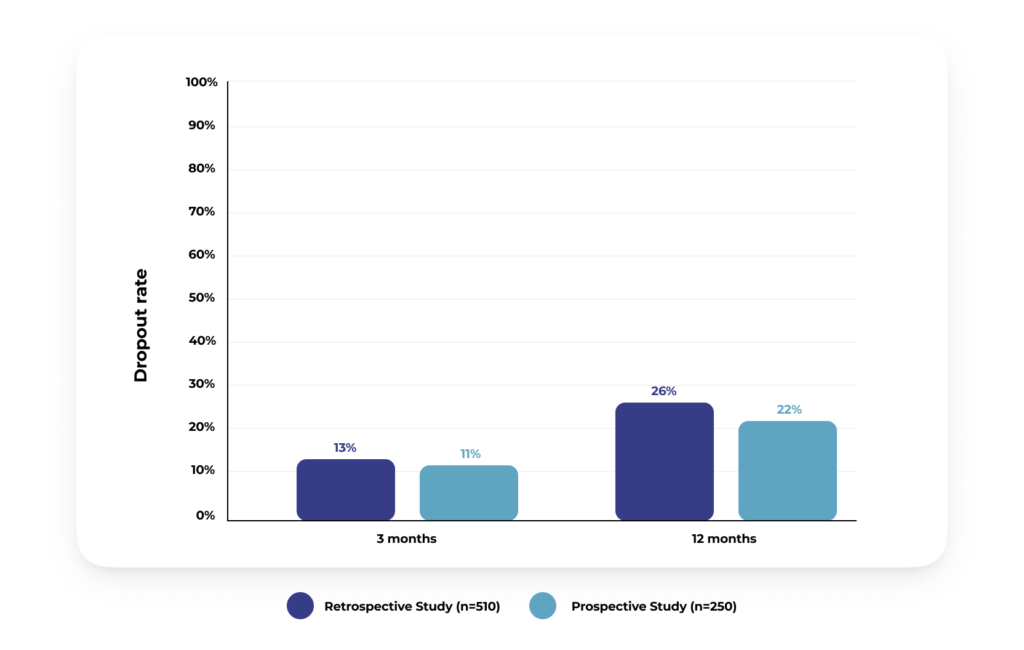Analysing Dropout to Understand Contact Lens Wear Satisfaction

As we saw in our previous blog post, contact lens usage dramatically decreases around age 40. Maybe it is worth taking the time to analyse why this happens.
This critical age overlaps with the beginning of presbyopia for several patients, so this is essentially related to multifocal and multifocal toric contact lenses. Patients may start using contact lenses or they may be already wearing monofocals.
Whether it is one or the other, it is up to the eye care professional to start the conversation. Once we have convinced the patient of the benefits of a contact lens, the race against dropping out begins. Despite all the improvements in soft lens materials, replacement frequency, designs, etc., dropouts remain a huge problem for eye care professionals.
In general, data indicates that “after five years of lens wear, approximately one-third of lens wearers had dropped out”.1 Also, studies suggest that the main causes for contact lens dropout differ depending on whether the user is a neophyte or already wearing contact lenses.
Fitting a neophyte patient
Sulley et al carried out two studies to determine the retention rate (RR) for neophyte patients fitted with contact lenses (CLs) in representative UK eye care practices:
- A multi-site study through a retrospective chart review.2 During the first year of CL wear, the overall RR was 74% (sphericals 79%, torics 73% and multifocals 57%).
- A prospective study through a sponsor-masked registry.3 After one year of use, RR was 77.6% (sphericals 81%, torics 75% and multifocals 69%).
It is important to note that retention rates decrease for torics and multifocals when compared to spherical lenses. These results are consistent between themselves and with data obtained in other studies.

The following question is obvious: why did around 25% of the patients stop wearing contact lenses? The researchers had the same question and wanted to identify factors associated with retention and dropout. In the following table, we can see a summary of both studies:

In summary, although they may appear in combination, there are four main reasons for dropping out (in order of importance):
1. Vision
Since we are talking about new wearers, it is possible that vision was more critical because their vision quality was not the same as with spectacles (for example, due to inadequate contact lens power).
2. Comfort
Comfort might not have been such an issue because soft lenses are under continuous improvement or because their neophyte eyes were brand new and contact lenses tolerance was better.
3. Handling
As for handling, it is true that it can be tricky at first. Also, hand problems are common in the population aged over 504 when presbyopic lenses are going to be needed and retention rate is poorer.
4. Motivation
With regards to motivation, patient needs and expectations should be the number-one topic of the conversation always through the fitting process and, above all, after the user leaves with a new pair of contact lenses. By doing so, a shift could be detected and addressed.
Fitting a patient already wearing contact lenses
Since the 1990s, the reasons for discontinuing contact lens wear have been evaluated in several studies.
Among established wearers, the main reasons for dropout change. Discomfort and/or dryness are the primary reasons, reported by around half of those who lapse. Poor vision, handling difficulties and cost are the other reasons reported by lapsed contact lens wearers.
Dumbleton et al5 found out that lapsed wearers were older, had started lens wear later in life, and had not worn lenses for as long as non-lapsed wearers. This is a clear reflection of presbyopic patients commencing with contact lens wear. Again, the primary reasons for dropping out were discomfort and dryness.
In a more recent study, Rueff et al6 carried out a survey amongst presbyopic contact lens wearers only. They learned that discomfort and poor vision were the primary reasons for discontinuation. Also, convenience and cost were mentioned by their respondents. In general, lapsed wearers had worse overall opinions of their vision at all distances. The results of this survey suggest that presbyopes have unique demands and opinions related to contact lens wear.
Conclusions
Firstly, vision is the main problem for neophytes and, above all, for presbyopic patients. Secondly, comfort becomes a bigger issue when the patient has been wearing contact lenses for a while. Thirdly, there are always subsidiary causes such as handling, convenience and cost that eye care professionals must not forget.
At mark’ennovy, we believe that contact lens wear satisfaction can be improved addressing those factors. That’s why we manufacture our individually crafted contact lenses with an extended range of powers and additions, an unrivalled combination of diameters and base curves, but also with different types of materials. We will be exploring different strategies to increase patient satisfaction on the next blog post. Stay tuned!
Do you have any questions? Would you like more information?
Contact your Senior Regional Sales Manager for more information or contact our specialised technical support team: 0800 328 0610 (M-F 9 am to 5 pm) or mkservices@markennovy.com
References
- Contact Lens Spectrum. 2020. Dropping the dropout rate. [ONLINE] Available at: https://www.clspectrum.com/issues/2020/may-2020/dropping-the-dropout-rate. [Accessed 18 February 2022].
- Sulley A, Young G, Hunt C. Factors in the success of new contact lens wearers. Cont Lens Anterior Eye. 2017 Feb;40(1):15-24. doi: 10.1016/j.clae.2016.10.002. Epub 2016 Nov 3. PMID: 27818113.
- Sulley A, Young G, Hunt C, McCready S, Targett MT, Craven R. Retention Rates in New Contact Lens Wearers. Eye Contact Lens. 2018 Sep;44 Suppl 1:S273-S282. doi: 10.1097/ICL.0000000000000402. PMID: 28617731.
- Eli Carmeli, Hagar Patish, Raymond Coleman, The Aging Hand, The Journals of Gerontology: Series A, Volume 58, Issue 2, February 2003, Pages M146–M152, https://doi.org/10.1093/gerona/58.2.M146
- Dumbleton K, Woods CA, Jones LW et al. The impact of contemporary contact lenses on contact lens discontinuation. Eye Contact Lens 2013; 39:93-9.
- Rueff EM, Varghese RJ, Brack TM, Downard DE, Bailey MD. A Survey of Presbyopic Contact Lens Wearers in a University Setting. Optom Vis Sci. 2016 Aug;93(8):848-54. doi: 10.1097/OPX.0000000000000881. PMID: 27232896.
Multifocal & Toric contact lenses, consistently shipped in 72 HOURS.
25
April 2022







 Academy
Academy
Leave a Reply